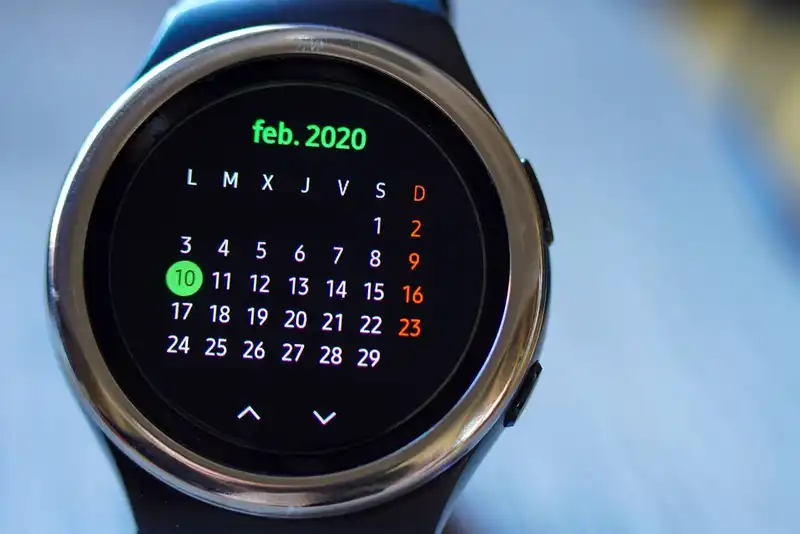What is real time clock ?
Real time clock or RTC is a clock which shows the time in relation to a particular date and time. It is a very important feature of your mobile or tablet, as it enables you to set the correct time and date for any appointment or task. The RTC usually consists of a battery-backed clock chip or an atomic clock. The RTC is usually built-in the mobile or tablet but can be added as an accessory. So, when do you need real time clock ?
The 4 Different Types of Real Time Clocks and How They Work
What is a Real Time Clock?
There are many uses for an RTC or a real-time clock, but the most important one is providing accurate time and date. The RTC is an integrated circuit (IC) that can be packaged in a variety of ways. Powered by a lithium battery that is built-in. As a result, even if the system's power is turned off, the RTC clock continues to operate.
Digital clocks, attendance systems, and digital cameras are all examples of systems that rely heavily on this technology. Clock RTC is a good choice for applications that require a time stamp. Such an application has always been best designed using the clock RTC, even if the initial setup can be challenging.
For any real-time process that deals with time, there are usually two methods to handle the issue. The controller's timers can be programmed to generate the time internally, or an RTC can be used. Most system clocks use clock signals to monitor and control time, but RTC ICs use a crystal oscillator instead. RTC ICs are also responsible for ensuring that all system processes are properly synchronized, in addition to being responsible for the system's clock. Although some may argue that this is the job of the system clock, the RTC is actually dependent on the system clock, making synchronization the RTC indirectly responsible.
The battery life of an RTC should be at least three to five years.
Benefits of a Real Time Clock

The 5 major benefits of a real time clock are-
- Intuitive Software Creation
A clock function with an MCU requires designers to write software that manages the complex calendar and time, such as long and short months, leap year, base 24 scale, sexagesimal, and more.
In contrast, clock RTCS are designed specifically for time management; and include circuits that can keep the time and calendar until 100 years and they are easy to code.
- One-Chip Oscillator
An external crystal oscillator is all that is needed to build an oscillator circuit since all of the other components are already included in RTCs.
Oscillator circuits are simple to design due to the limited number of outside components required.
- The supply current is lower than that of an MCU.
An RTC backup circuit can lower the cost and the size of a backup circuit, and it is designed to operate at lesser voltages and currents than a time-keeping circuit built with a Microcontroller.
- It relieves the primary system of time-sensitive tasks.
- It consumes ultra low power and maintains a more stable frequency.
The world has changed. The time we keep is different than it used to be.
Zipschedules suggests that with a real time clock, you can keep up with the ever-changing world. You no longer have to worry about the date, time, or year because your clock will do that for you!
How Real Time Clocks Work?
Real-Time Clocks are timers that operate on a one-second basis. Additionally, an RTC is frequently used in software/hardware operating systems to keep track of the clock time and calendar date. Numerous features of an RTC are highly specialized and are required to maintain high accuracy and reliability.
RTCs frequently include their own internal oscillator that comes with an external crystal. All clock sources operate at a frequency of 32,768 Hz. With an external clock source, a highly accurate and stable device such as a temperature-compensated crystal oscillator (TCXO) can be used.
A multiplexer selects a clock source and feeds it to a Prescaler, which divides it by a variable of 32,768 (215) to generate a one-second clock.
A real Time Clock RTCS contains a seconds counter that is typically 32 bits or larger. Certain RTCs include dedicated counters for keeping track of the time of day and managing calendar dates as well.
A simple clock RTCS without the time and date specification accomplish this task through the use of the software. A frequently used option is to generate a 1 Hz square wave from an output pin. An RTC can generate a processor interruption in response to a number of different events.
Often, an RTC has a dedicated power pin that enables it to operate when the rest of the microcontroller is turned off. Typically, this power pin is attached to a battery backup or an external device that gives power.
Types of Real Time Clocks

Generally, there are three types of time clocks RTCS-
1. Real time clock with radio-
Today's computers use digital radio to receive clock information. Two methods are used- For example, LTE provides the current local time. Use the network time protocol if an online radio is available. Local time servers every so often uses GPS[19] or UHF radio transmissions from a national standards organization.
2. Real time clocks in software-
Embedded system programmers who must create RTCs in systems lacking them are familiar with this system. Most computers have hardware timers that use quartz crystal or ceramic resonator timing signals. These have very repeatable absolute timing (often less than 1 ppm). The software can convert these to accurate RTCs. It can produce a periodic interrupt, e.g. 50 Hz, to mimic an RTC But it uses math to fine-tune the timing chain- time + rate
When "time" exceeds a constant, usually a power of two, the clock's timing-chain software is triggered to count fractions of seconds, etc. Rate resolution can exceed one part per billion with 32-bit time and rate variables. Because it skips fractions of a second or increments twice, the clock is still accurate. Almost all real-world RTC applications ignore the tiny jitter.
The complexity of this system is determining the corrected instantaneous rate. The simplest system divides reference time by clock time RTCS is to find the rate. Because internet time is often accurate to within 20 milliseconds, 8000 seconds (2.2 hours) or more between settings can usually reduce the error to less than 5 parts per million. The main challenge is converting dates and times to seconds, but the methods are well known.
When a unit is off, the RTC usually runs at two rates, one when the unit is on and one when it is off. Because each state's temperature and voltage are constant. So the software calculates two rates. Two linear equations are solved to calculate different rates, one for on and one for off.
Another method measures the oscillator's temperature with an electronic thermometer and uses a polynomial to calculate the rate once per minute. It is widely used by Small Business as it calibrates the frequency at various temperatures, then uses linear regression to find the temperature equation. Most quartz crystals in a system are SC-cut, and their rates over temperature are 3rd-degree polynomials. This approach may be used in commercial RTC ICs, but the actual manufacturing methods are proprietary.
3. Real time clock in the past-
Smaller IBM System/360s, PDP-83, and Novas used low-cost Time Clocks. In Europe, North America, and other grids, the AC mains are tuned to meet long-term frequency accuracy standards. Clocks powered by AC mains keep perfect time in those grids and help generate correct information of time in storing and regulating Time Management software in offices. These clocks are not suitable for portable computers or grids in South Asia.
These computers' power supplies produce a sine wave using a transformer or resistor divider. A zero frequency response detector conditions this signal. The result is a square wave with single fast edges. This logic signal interrupts. In most cases, interrupt handler software counts cycles. It can thus provide a clock and calendar. The interrupt updates a 64-bit microsecond count used by standard systems software. Interrupting for each zero crossing reduces jitter error by half.
The clock was also used in software timing chains, such as the timer used to switch tasks in an operating system. Modern computers' counting timers provide similar functions with less precision and may be derived from this type of clock.
It must be set each time the computer is started. Originally, computer operators did this. This type of clock was automatically set when the Internet became common.
Discrete Real Time Clock (DCT)
This method essentially shows how to use an AVR microcontroller that has the clock time module to make a real time clock RTC. A 32.768kHz watch crystal is one discreet component needed for the implementation. A lot of the time, the microcontroller is in Power-save mode. This means that the application doesn't use very much power. A timer is only running when the AVR controller is in power-saving mode. The timer is logged by the crystal on the outside. A Timer overflow means the time, date, and month are all added up. This RTC implementation is written for the ATmega128, but it can be easily changed to work with other AVRs that have the RTC Module, like the AVR32. It is the most used Time Tracking device that checks the clock in real-time.
The advantages of making an RTC in software instead of using an external hardware RTC are clear-
- Lower cost
- Fewer external parts
- Low power
- More flexibility
Tracking time can be hard, especially when you have to do it for more than one thing.
Zipschedules suggest that real time clock can be powered by an external power supply or with a solar panel.
Real Time Clock with Calendar (RTCC)

A Real-Time Clock/Calendar (RTCC) keeps embedded systems running at the right time even when the main power is out. This is a big advantage over RTCCs that are built into microcontrollers (MCUs) because it saves power by not disturbing the MCU up over and over again. There are simple, low-cost clocks for I2C and Serial Peripheral Interface (SPI), as well as high-integration clocks with more user-available memory (SEEPROM and SRAM) and a range of features that are useful when using a single battery-backed clock device. These cost-effective solutions have better features and performance as compared to other devices on the market, meeting all your requirements.
Some examples of how RTCCs can be used-
1. Use an RTCC with a MAC address to make it possible for devices in smart energy applications to talk to each other over wired and wireless networks.
2. Use digital thinning in the RTCC to do software temperature compensation so that utility metering applications can keep track of time more accurately.
3. Use the RTCC's EUI-48 or EUI-64 MAC address to give any Ethernet application its own unique ID.
4. In any embedded system, you can show the time and date on the LCD screen.
Real Time Clock with Weekday Adaptation (RTWC)
An RTC circuit keeps track of time even if the main power goes out.
Many applications use real-Time Clocks, including industrial, and consumer such as digital cameras, mobile GPS, TV, and home healthcare. Most electronic applications use a 32.768kHz quartz optimal control crystal oscillator.
Because the real-time clock counts seconds, it requires a 1Hz clock signal from the 32.768kHz crystal oscillator. The time and date are stored in a set of registers accessed via a communication interface like I2 C. The crystal can be separated or integrated with the RTC. For more precise applications, a MEMS (microelectromechanical system) resonant frequency is used. It is highly efficient when checking the time clock on an everyday basis or defining and setting alarms for weekdays and so on.
Real Time Clock with Daylight Savings Adaptation (RTCDW)

The real time clock rtcs keeps records of the second, minute, hour, day of the week, month, and year. The day of the week is instantly worked out from the day, month, and year. Daylight saving time can be turned on or off, and it can be set to start and end at any time. It also has a programmable saving time. Second, minute, hour, day, month, and year are all covered by the alarm in power management. It can tell when two things happen to be the same. What time and date information will be used to make the alarm and so on.
User code stubs can be used to run code on a regular basis based on each of the main time intervals. There are different time intervals such as one second, a minute, an hour, one day, a week, a month, or a year. This parameter lets you decide whether or not the RTC component can use daylight saving time. The default value isn't checked, so it's not checked (false).
It's Monday.
The start of the week parameter lets you choose what day of the week it starts on. There are a lot of choices- "Sunday"- Sunday is the start of the week. You can also choose "Monday," "Tuesday," and "Wednesday." "Thursday"- Thursday is the start of the week. "Friday," "Saturday," and "Monday" are the other choices, too.

Knowing the time is important, but it can be difficult to remember what time it is.
Zipschedules says a real time clock can be powered by an external power supply or with a solar panel.
















































































